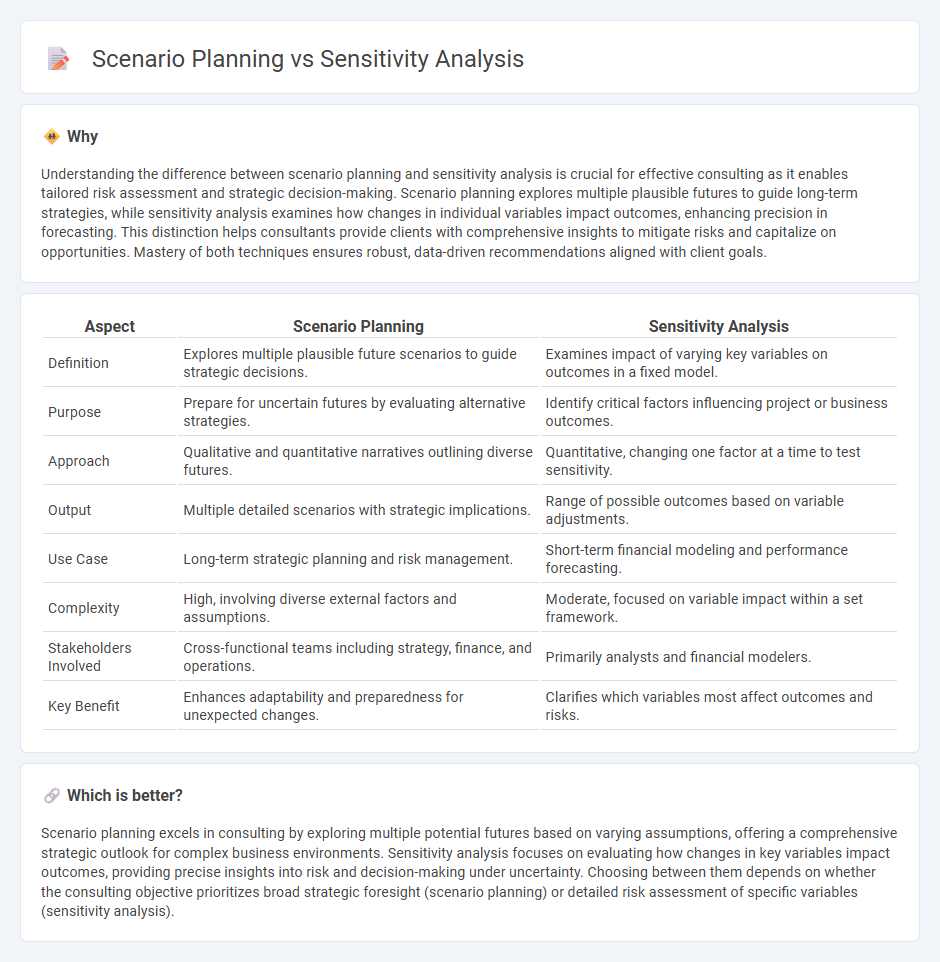
Scenario planning examines multiple plausible future environments by creating detailed narratives to understand long-term risks and opportunities. Sensitivity analysis quantifies how changes in individual variables impact a specific outcome, focusing on short-term variability and key drivers. Discover how these strategic tools complement each other to enhance decision-making and risk management.
Why it is important
Understanding the difference between scenario planning and sensitivity analysis is crucial for effective consulting as it enables tailored risk assessment and strategic decision-making. Scenario planning explores multiple plausible futures to guide long-term strategies, while sensitivity analysis examines how changes in individual variables impact outcomes, enhancing precision in forecasting. This distinction helps consultants provide clients with comprehensive insights to mitigate risks and capitalize on opportunities. Mastery of both techniques ensures robust, data-driven recommendations aligned with client goals.
Comparison Table
| Aspect | Scenario Planning | Sensitivity Analysis |
|---|---|---|
| Definition | Explores multiple plausible future scenarios to guide strategic decisions. | Examines impact of varying key variables on outcomes in a fixed model. |
| Purpose | Prepare for uncertain futures by evaluating alternative strategies. | Identify critical factors influencing project or business outcomes. |
| Approach | Qualitative and quantitative narratives outlining diverse futures. | Quantitative, changing one factor at a time to test sensitivity. |
| Output | Multiple detailed scenarios with strategic implications. | Range of possible outcomes based on variable adjustments. |
| Use Case | Long-term strategic planning and risk management. | Short-term financial modeling and performance forecasting. |
| Complexity | High, involving diverse external factors and assumptions. | Moderate, focused on variable impact within a set framework. |
| Stakeholders Involved | Cross-functional teams including strategy, finance, and operations. | Primarily analysts and financial modelers. |
| Key Benefit | Enhances adaptability and preparedness for unexpected changes. | Clarifies which variables most affect outcomes and risks. |
Which is better?
Scenario planning excels in consulting by exploring multiple potential futures based on varying assumptions, offering a comprehensive strategic outlook for complex business environments. Sensitivity analysis focuses on evaluating how changes in key variables impact outcomes, providing precise insights into risk and decision-making under uncertainty. Choosing between them depends on whether the consulting objective prioritizes broad strategic foresight (scenario planning) or detailed risk assessment of specific variables (sensitivity analysis).
Connection
Scenario planning and sensitivity analysis are interconnected tools in consulting that enhance decision-making under uncertainty. Scenario planning explores multiple future states by assessing the impact of different variables, while sensitivity analysis quantifies how changes in individual inputs influence outcomes. Combining these methods enables consultants to identify critical factors driving business risks and opportunities, improving strategic resilience.
Key Terms
Variables
Sensitivity analysis examines the impact of changes in individual variables on a model's outcomes, isolating the effect of specific parameters like interest rates or demand forecasts. Scenario planning explores multiple, coherent sets of variables simultaneously, assessing how diverse situations such as economic downturns or regulatory shifts influence strategic decisions. Discover how mastering these techniques enhances risk management and decision-making processes.
Assumptions
Sensitivity analysis evaluates how changes in individual assumptions impact model outcomes, isolating the effect of varying one parameter at a time to identify critical factors. Scenario planning explores multiple, coherent sets of assumptions to imagine different future conditions, capturing a broader range of uncertainties and their combined influence. Discover more about refining your decision-making using these assumption-focused techniques.
Outcomes
Sensitivity analysis evaluates how changes in individual variables impact specific outcomes, quantifying the effect of uncertainty in model inputs. Scenario planning explores multiple plausible future environments by assessing diverse combinations of variables and their potential impacts on long-term outcomes. Discover detailed methodologies and practical applications to optimize decision-making under uncertainty.
Source and External Links
Sensitivity analysis - Sensitivity analysis studies how uncertainty in model inputs affects the output, often by running the model multiple times with varying inputs and calculating sensitivity measures like regression coefficients or variance decompositions.
What is Sensitivity Analysis? - Sensitivity analysis is a tool primarily used in financial modeling to assess how changes in independent variables impact a dependent output, often framed as "what-if" scenarios under defined input boundaries.
Sensitivity Analysis Explained: Definitions, Formulas and ... - Sensitivity analysis involves modifying input variables by a specified amount (like 10%) to see the impact on model outputs, with common usage including testing interest rate effects in financial contexts.
 dowidth.com
dowidth.com